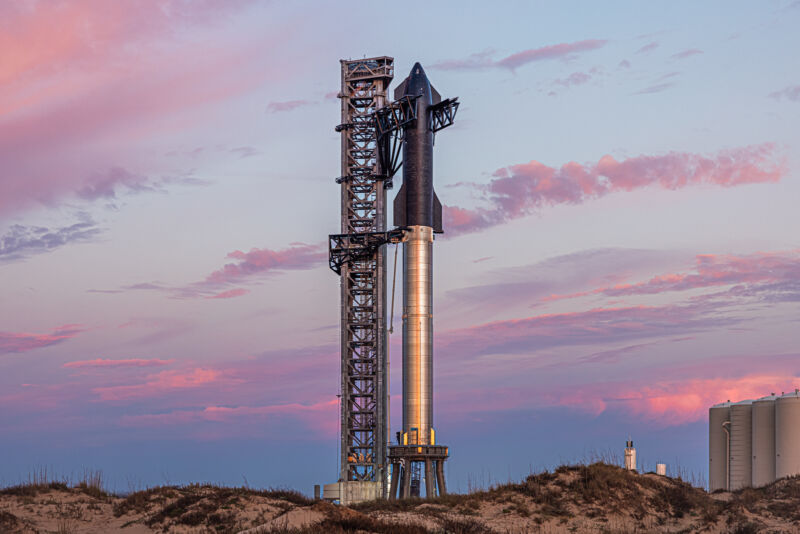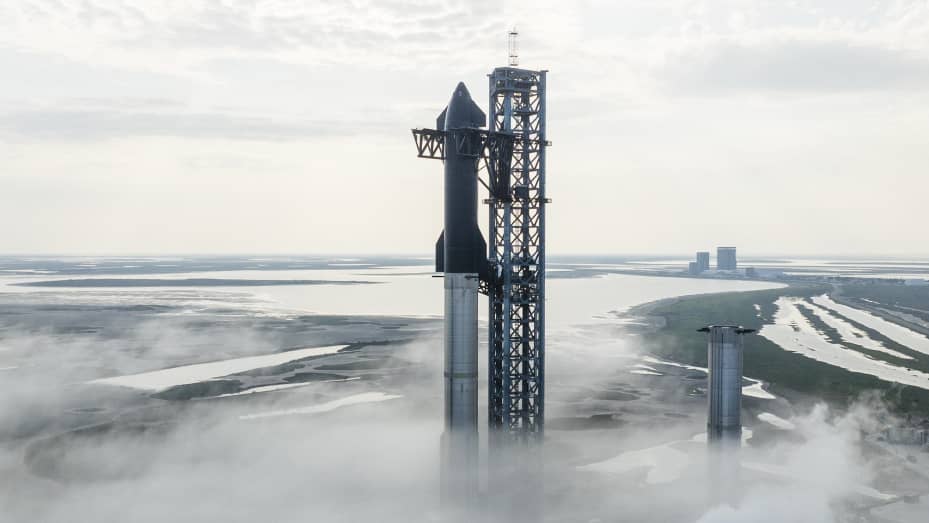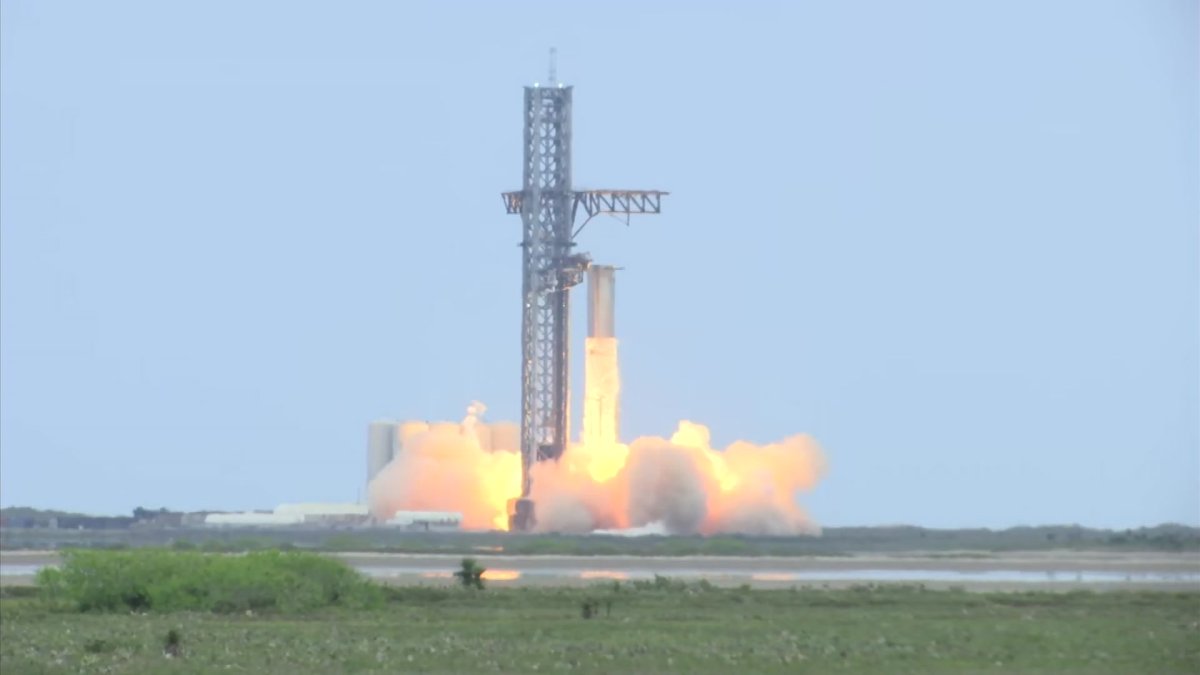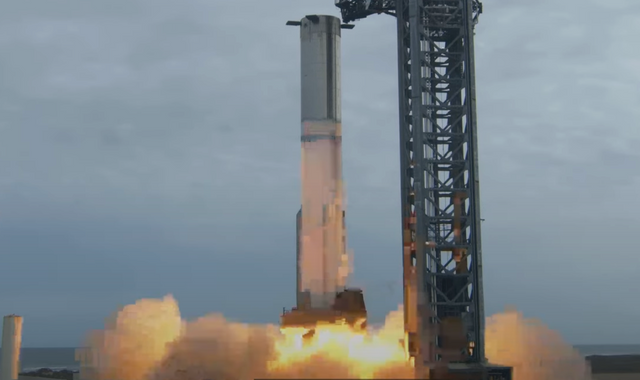SpaceX tests the most powerful rocket engines ever.

The most potent rocket ever constructed, which SpaceX plans to use to launch people to the Moon and beyond, successfully tested its engines on Thursday. At the Texas site of the for-profit space corporation, the static fire test of the 33 Raptor engines on the Starship’s first-stage booster took place.
Elon Musk, the creator of SpaceX, said that one engine was shut off shortly before the test began, and another engine shut itself off. Musk tweeted, “So 31 engines fired in total.” According to SpaceX, the test lasted “the entire length.”
The test fire, which lasted several seconds, produced enormous sheets of orange flames and billowing clouds of smoke into the air. The 230-foot (69-meter) Super Heavy rocket was fastened to the ground during the test launch to keep it from lifting. The first-stage rocket that was tested on Thursday and a reusable capsule for personnel and cargo make up the starship.
SpaceX’s president and COO, Gwynne Shotwell, stated at a conference in Washington on Wednesday that since the test was a success, the business’s maiden orbital launch may take place in roughly a month. Before we fire ’em up and take off, this is the last ground test we can conduct, according to Shotwell.
The US space agency will utilise the Space Deliver System, a powerful rocket that has been in development for more than 10 years, to launch people into lunar orbit. The Starship is more substantial and powerful than the SLS. It generates 17 million pounds of thrust, which is more than twice as much as the Saturn V rockets used to send the Apollo astronauts to the Moon.
Future starship launches by SpaceX will be fueled by another spacecraft in orbit before continuing their journey to Mars or other planets.Other super-heavy rockets under development include the New Glenn from Blue Origin, the Long March 9 from China, and the Yenisei from Russia.
What is the SpaceX Starship?
The Starship is a super-heavy-lift rocket and spaceship designed to transport a large amount of cargo and several humans into the reaches of the universe. The Space Launch System rocket from NASA is dwarfed by the 400-foot-tall stainless steel tower. To compare with Musk’s spacecraft, place around five billboards on top of the latter. According to SpaceX, its rocket has almost twice as much thrust.
The rocket is built of stainless steel, which Musk particularly likes because of how inexpensive it is. This monster is powered by 10 million pounds of liquid methane and oxygen, in contrast to NASA’s mammoth moon rocket, which uses super-chilled liquid hydrogen and oxygen to fly. The new fuel requires less insulation and is less prone to leaks, an issue that frequently delays NASA missions since it can be stored at more controllable temperatures than liquid hydrogen.
The goal of Starship is to develop a completely reusable launch and landing system for missions to the moon, Mars, and other planets. Because it would make spaceflight more accessible to the common person, its reusability is “the holy grail of space,” according to Elon Musk, who made this statement at a corporate event in South Texas last February.
How will NASA use Star ship?
When NASA launches Artemis III and IV, two planned missions that might launch as early as 2025 and 2027, respectively, it expects to employ starships to land people on the moon. With a $4 billion contract, the space agency has chosen SpaceX to create a Starship version with a human landing mechanism. The business will have to show proof of an unmanned test mission to the moon to close the transaction.
During Artemis III, Starship will transport humans from NASA’s Orion spaceship to the lunar south pole and back. However, on the fourth voyage, Starship is planned to dock at the yet-to-be-constructed Gateway space station, which is circling the moon, and transport humans there and back.
Bill Nelson, the administrator of NASA, told reporters in December that SpaceX seemed to be following the contract’s timeline and planned to do an unmanned lunar landing by the end of the year. A second astronaut landing would come after that trip in late 2024.
Even though SpaceX has not publicly disclosed a date, the company is close to launching Starship. For a so-called “wet dress rehearsal,” the corporation placed the mammoth rocket at its launch pad on the Texas Gulf Coast and then filled it with fuel. A crucial trial run for any new rocket, according to SpaceX, was successful. The crew then said it will disassemble Starship for a test fire of the rocket booster’s 33 Raptor engines, according to recent tweets from SpaceX.
However, before Starship can take off, the Federal Aviation Administration must provide a launch permit. When asked about the issue in January, the agency replied in a statement supplied to Mashable that this won’t happen until SpaceX meets all licencing, safety, and other regulatory standards.
Where will Starship launch?
Unexpectedly, Starship won’t launch from Cape Canaveral, Florida’s Kennedy Space Center, where the majority of space enthusiasts are used to seeing historically notable launches. Instead, it will launch from SpaceX’s spaceport in Boca Chica, Texas. A facility that is now being built on the edge of the iconic Florida launch pad where Apollo 11 was flown to the moon will eventually serve as the business’s rocket launch site. Their plan, according to Nelson, “is that they’re going to conduct a few test flights there.” Once they feel more confident, they will bring the missions to the Cape.

How probable is Starship’s success?
Many of the Starship incomplete prototypes that SpaceX has flown to do landing practise have crashed or detonated. However, one did manage to land safely after ascending roughly six miles in May 2021. Musk once stated that it was unlikely that Starship’s test in orbit would be successful on the first attempt since he doesn’t mince words when it comes to the reality of spaceflight. He said, “There’s a lot of risk linked with this first launch, therefore I would not predict that it is going to be successful,” in a 2021 video conference with a National Academies panel.
By 2050, SpaceX’s founder wants to send a million people to Mars on a fleet of Starships. To be clear, Musk wants to create a community that can sustain itself in addition to a tourist destination. He believes that a small amount of warming may restore Mars’s thick atmosphere and oceans, making the planet more habitable and even enabling agricultural production.
Do you succeed in getting to the second planet? is an important turning point in the history of pretty much any civilization on one planet. Musk gave a speech at the National Academies in 2021. 100 people, their luggage, plus enough building materials to build a city, a business, a rocket fuelling station, and an iron foundry would fit aboard the ship. The Starship would provide entertainment choices including zero-gravity games, movies, lectures, and a restaurant even though Musk recognised that the journey there would be lengthy.
edited and proofread by nikita sharma





